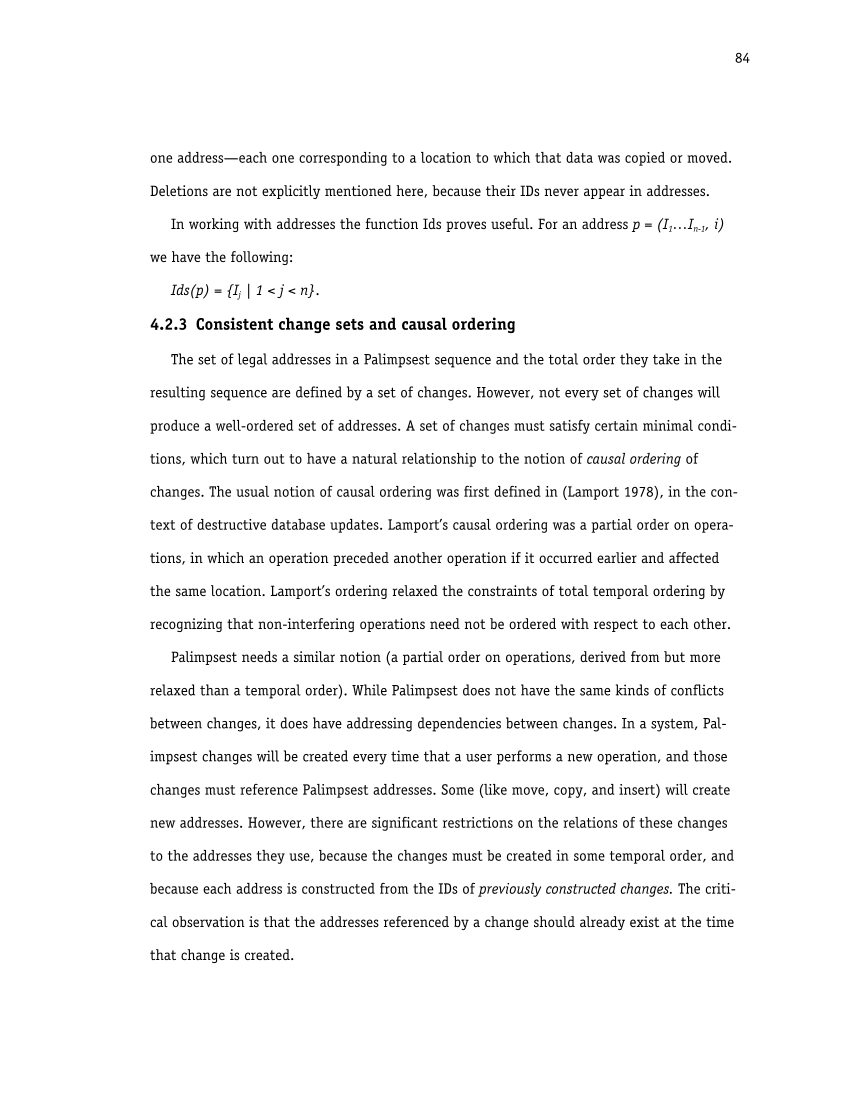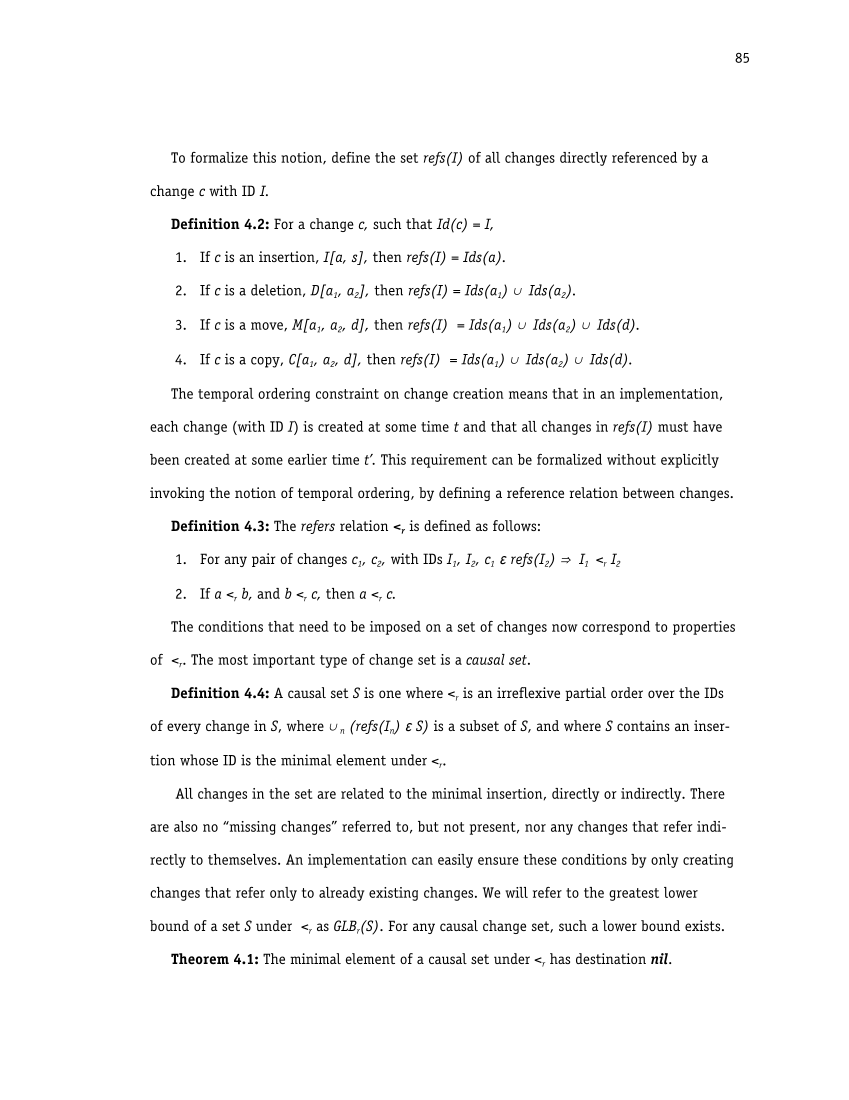84
one�address—each�one�corresponding�to�a�location�to�which�that�data�was�copied�or�moved.
Deletions�are�not�explicitly�mentioned�here,�because�their�IDs�never�appear�in�addresses.
In�working�with�addresses�the�function�Ids�proves�useful.�For�an�address�p = (I
1 …I
n-1 ,�i)
we�have�the�following:
Ids(p) = {I
j | 1 < j < n}.
4.2.3 Consistent�change�sets�and�causal�ordering
The�set�of�legal�addresses�in�a�Palimpsest�sequence�and�the�total�order�they�take�in�the
resulting�sequence�are�defined�by�a�set�of�changes.�However,�not�every�set�of�changes�will
produce�a�well-ordered�set�of�addresses.�A�set�of�changes�must�satisfy�certain�minimal�condi-
tions,�which�turn�out�to�have�a�natural�relationship�to�the�notion�of�causal�orderingof
changes.�The�usual�notion�of�causal�ordering�was�first�defined�in�(Lamport�1978),�in�the�con-
text�of�destructive�database�updates.�Lamport’s�causal�ordering�was�a�partial�order�on�opera-
tions,�in�which�an�operation�preceded�another�operation�if�it�occurred�earlier�and�affected
the�same�location.�Lamport’s�ordering�relaxed�the�constraints�of�total�temporal�ordering�by
recognizing�that�non-interfering�operations�need�not�be�ordered�with�respect�to�each�other.
Palimpsest�needs�a�similar�notion�(a�partial�order�on�operations,�derived�from�but�more
relaxed�than�a�temporal�order).�While�Palimpsest�does�not�have�the�same�kinds�of�conflicts
between�changes,�it�does�have�addressing�dependencies�between�changes.�In�a�system,�Pal-
impsest�changes�will�be�created�every�time�that�a�user�performs�a�new�operation,�and�those
changes�must�reference�Palimpsest�addresses.�Some�(like�move,�copy,�and�insert)�will�create
new�addresses.�However,�there�are�significant�restrictions�on�the�relations�of�these�changes
to�the�addresses�they�use,�because�the�changes�must�be�created�in�some�temporal�order,�and
because�each�address�is�constructed�from�the�IDs�of�previously�constructed�changes.The�criti-
cal�observation�is�that�the�addresses�referenced�by�a�change�should�already�exist�at�the�time
that�change�is�created.
one�address—each�one�corresponding�to�a�location�to�which�that�data�was�copied�or�moved.
Deletions�are�not�explicitly�mentioned�here,�because�their�IDs�never�appear�in�addresses.
In�working�with�addresses�the�function�Ids�proves�useful.�For�an�address�p = (I
1 …I
n-1 ,�i)
we�have�the�following:
Ids(p) = {I
j | 1 < j < n}.
4.2.3 Consistent�change�sets�and�causal�ordering
The�set�of�legal�addresses�in�a�Palimpsest�sequence�and�the�total�order�they�take�in�the
resulting�sequence�are�defined�by�a�set�of�changes.�However,�not�every�set�of�changes�will
produce�a�well-ordered�set�of�addresses.�A�set�of�changes�must�satisfy�certain�minimal�condi-
tions,�which�turn�out�to�have�a�natural�relationship�to�the�notion�of�causal�orderingof
changes.�The�usual�notion�of�causal�ordering�was�first�defined�in�(Lamport�1978),�in�the�con-
text�of�destructive�database�updates.�Lamport’s�causal�ordering�was�a�partial�order�on�opera-
tions,�in�which�an�operation�preceded�another�operation�if�it�occurred�earlier�and�affected
the�same�location.�Lamport’s�ordering�relaxed�the�constraints�of�total�temporal�ordering�by
recognizing�that�non-interfering�operations�need�not�be�ordered�with�respect�to�each�other.
Palimpsest�needs�a�similar�notion�(a�partial�order�on�operations,�derived�from�but�more
relaxed�than�a�temporal�order).�While�Palimpsest�does�not�have�the�same�kinds�of�conflicts
between�changes,�it�does�have�addressing�dependencies�between�changes.�In�a�system,�Pal-
impsest�changes�will�be�created�every�time�that�a�user�performs�a�new�operation,�and�those
changes�must�reference�Palimpsest�addresses.�Some�(like�move,�copy,�and�insert)�will�create
new�addresses.�However,�there�are�significant�restrictions�on�the�relations�of�these�changes
to�the�addresses�they�use,�because�the�changes�must�be�created�in�some�temporal�order,�and
because�each�address�is�constructed�from�the�IDs�of�previously�constructed�changes.The�criti-
cal�observation�is�that�the�addresses�referenced�by�a�change�should�already�exist�at�the�time
that�change�is�created.





























































































































































































